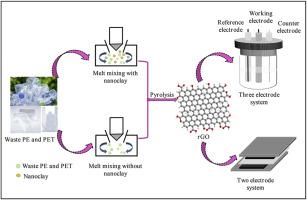废塑料可持续转化为用于超级电容器的还原氧化石墨烯:一种比较电解质的研究
IF 7.9
2区 工程技术
Q1 CHEMISTRY, PHYSICAL
引用次数: 0
摘要
本研究研究了通过纳米粘土辅助熔融混合和热解工艺,将废聚乙烯(PE)和聚对苯二甲酸乙二醇酯(PET)升级回收为还原氧化石墨烯(rGO)。使用硫酸(H2SO4)、氢氧化钾(KOH)和氯化钾(KCl),在三电极配置中进行比较电化学评价。PE_0.5-rGO在1 M H2SO4中,在0.5 a /g条件下的比电容达到482.9 F/g,表现最好。在双电极系统中的进一步测试揭示了增强的电容和出色的循环稳定性,强调了实际应用的潜力。该器件在280 W/kg功率密度下的最大能量密度为53.5 Wh/kg。此外,该器件表现出显著的长期循环稳定性,在12,000次充放电循环后保持约83.1%的初始电容。这些发现证明了将塑料废物转化为高性能超级电容器材料的有效途径。本文章由计算机程序翻译,如有差异,请以英文原文为准。

Sustainable conversion of waste plastic into reduced graphene oxide for superior supercapacitor applications: A comparative electrolyte study
The present study investigates the upcycling of waste polyethylene (PE) and polyethylene terephthalate (PET) into reduced graphene oxide (rGO) through a nanoclay-assisted melt mixing and pyrolysis process. A comparative electrochemical evaluation is performed using sulfuric acid (H2SO4), potassium hydroxide (KOH), and potassium chloride (KCl), electrolytes in a three-electrode configuration. The rGO derived from PE with 0.5 wt% nanoclay catalyst (PE_0.5-rGO) exhibits as the best performer, achieving a specific capacitance of 482.9 F/g at 0.5 A/g in 1 M H2SO4. Further testing in a two-electrode system reveals enhanced capacitance and excellent cyclic stability, underscoring the potential for practical applications. The fabricated device executes a maximum energy density of 53.5 Wh/kg at a power density of 280 W/kg. Additionally, this device shows remarkable long-term cycling stability, retaining approximately 83.1 % of its initial capacitance after 12,000 charge-discharge cycles. These findings demonstrate an efficient route for converting plastic waste into high-performance supercapacitor materials.
求助全文
通过发布文献求助,成功后即可免费获取论文全文。
去求助
来源期刊

Journal of Power Sources
工程技术-电化学
CiteScore
16.40
自引率
6.50%
发文量
1249
审稿时长
36 days
期刊介绍:
The Journal of Power Sources is a publication catering to researchers and technologists interested in various aspects of the science, technology, and applications of electrochemical power sources. It covers original research and reviews on primary and secondary batteries, fuel cells, supercapacitors, and photo-electrochemical cells.
Topics considered include the research, development and applications of nanomaterials and novel componentry for these devices. Examples of applications of these electrochemical power sources include:
• Portable electronics
• Electric and Hybrid Electric Vehicles
• Uninterruptible Power Supply (UPS) systems
• Storage of renewable energy
• Satellites and deep space probes
• Boats and ships, drones and aircrafts
• Wearable energy storage systems
 求助内容:
求助内容: 应助结果提醒方式:
应助结果提醒方式:


